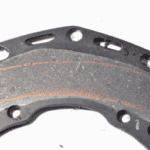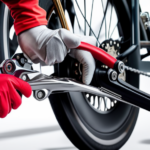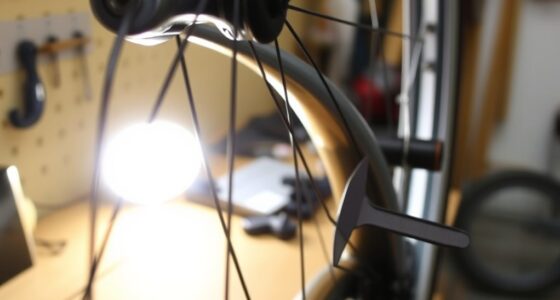Stop ignoring brake pad wear signs like squealing, grinding, or vibrations. Instead, schedule regular inspections and pay attention to these warning signals early. Never assume sounds or vibrations will go away on their own or that your brake system will fix itself over time. Avoid delaying professional help due to cost concerns or attempting DIY fixes without proper knowledge. Keep your brakes in top shape—there’s more to discover about maintaining safety and saving money.
Key Takeaways
- Don’t ignore squealing or grinding noises; have a professional inspect your brakes promptly.
- Avoid relying solely on brake response; visually check pad thickness and signs of uneven wear.
- Refrain from postponing brake inspections when you notice vibrations or reduced braking performance.
- Don’t attempt DIY repairs without proper tools; seek certified technicians for accurate diagnosis and repair.
- Stop delaying regular brake maintenance and fluid checks; routine inspections prevent costly future damage.
Ignoring the Squealing or Grinding Noises

When you hear squealing or grinding noises coming from your brakes, it’s a clear sign that something isn’t right. Ignoring these sounds can lead to serious issues like rotor corrosion, which damages the brake rotors and reduces braking efficiency. Squealing often indicates worn brake pads, but it can also signal that your brake fluid level is low or contaminated, affecting brake performance. Grinding sounds mean the brake pad material is completely gone, causing metal-to-metal contact that wears down the rotors. If you dismiss these signs, you risk costly repairs and compromised safety. Instead, have your brakes inspected promptly. Regular maintenance helps prevent rotor corrosion and keeps your brake fluid in good condition, ensuring your brakes work reliably when you need them most. Additionally, understanding the importance of proper brake system maintenance can help you avoid unexpected breakdowns and costly repairs.
Waiting Until Brake Pedal Feels Soft or Spongy

A soft or spongy brake pedal is a clear warning that your braking system isn’t functioning properly and demands immediate attention. This often indicates low brake fluid levels, air in the lines, or degraded rotor condition. Waiting until the pedal feels soft can lead to brake failure or costly repairs. Regularly check your brake fluid and inspect rotors for warping or damage to prevent this issue. Addressing issues early can help maintain optimal braking performance.
Assuming Noise Means Something Else

Although squealing or grinding noises from your brakes can signal serious issues, they sometimes stem from minor causes like dust, dirt, or worn brake pads. You might assume these noises indicate immediate danger, but noise misinterpretation can be misleading. Often, a high-pitched squeal is just the brake wear indicator, not a sign of damage. Similarly, vibration confusion can cause you to think your brakes are vibrating from warping or misalignment, but it might be due to loose components or debris. Jumping to conclusions can lead to unnecessary repairs or neglecting real problems. Instead, listen carefully and inspect your brakes to determine if the noise is just a minor issue or something requiring professional attention. Accurate diagnosis prevents unnecessary worry and ensures your safety. Regularly checking for signs of wear can help you catch issues early before they develop into more serious problems.
Delaying Inspection After Noticing Vibration

Ignoring vibration in your brakes can lead to serious damage and safety risks. Recognizing signs of brake wear early helps prevent costly repairs and keeps your vehicle safe. Getting an inspection promptly guarantees you catch problems before they worsen. Additionally, staying informed about vehicle safety developments can help you better understand how to maintain your brakes effectively.
Risks of Ignoring Vibration
When you notice vibration coming from your brake pedal or steering wheel, delaying an inspection can lead to serious consequences. Ignoring this sign risks uneven rotor alignment, which can cause further damage and reduce braking efficiency. Vibration often indicates issues like warped rotors or contaminated brake fluid, both of which compromise safety. If left unchecked, the problem can escalate, leading to more costly repairs and potential brake failure. Misaligned rotors increase wear on brake pads and can cause a grinding noise or reduced stopping power. Addressing vibration promptly helps maintain peak brake performance and prevents minor issues from turning into major safety hazards. Additionally, understanding the role of contrast ratio in brake system diagnostics can help identify underlying problems with braking performance. Don’t dismiss the warning—early inspection can save you time, money, and ensure your brakes function reliably.
Signs of Brake Damage
Noticing vibration in your brake pedal or steering wheel is a clear sign that your brakes may be damaged. Ignoring this symptom can lead to more severe issues. Here are key signs of brake damage to watch for:
- Uneven Brake Pad Wear: Indicates the need for brake pad replacement or brake system diagnostics to identify underlying problems.
- Squealing or Grinding Noises: Usually signals worn brake pads or rotor issues that require immediate attention.
- Reduced Braking Power: Suggests brake fluid leaks or damaged calipers, making brake system diagnostics essential. Additionally, brake system maintenance is crucial to ensure your brakes operate safely and effectively.
Addressing these signs promptly prevents further damage, keeps your braking system reliable, and ensures safety on the road. Don’t delay inspecting your brakes when you notice these warning signs.
Timely Inspection Benefits
Vibration in your brake pedal or steering wheel often signals an underlying issue that needs prompt attention. Ignoring this sign can lead to more costly repairs, like uneven rotor wear or misalignment. Regular, timely inspections help catch problems early, preventing further damage. When you inspect promptly, you can check the brake fluid level and quality, ensuring peak brake performance. Proper rotor alignment is also easier to verify, reducing vibrations and improving safety. Addressing vibrations early minimizes the risk of brake pad uneven wear and extends the life of your braking system. Additionally, early detection of issues can help identify other potential safety concerns before they become serious. In short, timely inspections save you money and keep your vehicle safe, ensuring that issues don’t escalate into major repairs. Don’t delay—trust your instincts and get that inspection done.
Believing Brake Wear Will Fix Itself Over Time

Many people think brake wear will improve on its own, but it rarely does. Ignoring early signs can lead to more serious damage and costly repairs down the line. Don’t wait too long—get a professional inspection before small issues turn into big problems. Regular vehicle maintenance can help identify brake issues early and prevent unexpected breakdowns.
Ignoring Early Signs
It’s common to think that brake wear will improve or disappear on its own over time, but ignoring early signs can lead to more serious problems. When you dismiss small issues, you risk damaging components like brake fluid seals or causing rotor misalignment. Here are three critical signs you shouldn’t ignore:
- Squealing noises when braking, indicating worn brake pads or issues with brake fluid.
- Vibration or pulsing in the brake pedal, which can signal rotor misalignment.
- A soft or spongy brake pedal, often caused by low brake fluid levels or leaks.
Addressing these early signs promptly helps prevent costly repairs and keeps your braking system functioning safely. Never assume brake problems will fix themselves—act now to avoid bigger issues later. Incorporating diverse designs in your vehicle’s brake system can also enhance safety and performance.
Delaying Professional Inspection
Some drivers believe that brake wear will improve or resolve itself over time, but this is a dangerous misconception. Brake pads don’t heal or fix themselves, and delaying a professional inspection can lead to serious issues. As brake wear progresses, you might notice changes like increased pedal height or a spongy feel, which indicate underlying problems. Ignoring these signs can cause your brake fluid to deteriorate or become contaminated, reducing braking efficiency. Relying on time alone won’t address uneven wear or hidden damage. Instead, schedule a professional inspection promptly. A mechanic can assess your brake system, check the brake fluid condition, and replace worn pads before safety is compromised. Regular brake maintenance is essential to prevent costly repairs and ensure optimal braking performance. Don’t wait for symptoms to worsen—early intervention saves money and keeps you safe.
Overlooking Visual Signs of Brake Pad Wear

Ignoring visual signs of brake pad wear can lead to more serious issues down the line. Your brake aesthetics often reveal early warning signs that you shouldn’t overlook. Recognize these visual cues to stay ahead:
- Squealing noises—a thin layer of brake pad material activates a built-in indicator, signaling it’s time to check your brakes.
- Uneven brake pad wear—noticeable differences in pad thickness can cause vibrations and reduce braking efficiency.
- Brake dust and metal debris—excessive buildup indicates pads are wearing down faster than normal, risking damage to rotors.
- Reduced braking response—a decline in braking performance may be linked to uneven or excessive wear, requiring inspection of the brake system.
- Visual inspection for pad thickness—regularly checking the brake pads’ thickness helps in timely maintenance and avoids unexpected failures.
Brake pad wear signs can be subtle but are crucial indicators of your vehicle’s safety.
Relying Solely on Brake Performance for Safety Checks

Relying only on brake response times and how the vehicle feels isn’t enough to guarantee safety. Unusual noises or vibrations can signal issues you might overlook if you focus solely on performance. Regular visual inspections are essential to catch signs of wear before they affect your braking ability. Additionally, monitoring brake pad wear signs and inspecting the components can help prevent costly repairs and ensure your safety on the road.
Brake Response Times
Brake response times are critical indicators of your vehicle’s safety, but they shouldn’t be the sole measure you rely on during safety checks. Relying only on brake response can be misleading, as other issues might cause safety delays. To get a complete picture, consider these steps:
- Pay attention to how quickly your brakes engage during normal driving.
- Test brake response in different conditions, like wet or dry roads.
- Watch for signs of uneven braking or delayed stopping, which can signal underlying problems.
- Remember that brake pad wear signs can also impact stopping efficiency and should be checked regularly.
Noise and Vibration Indicators
While good brake response is indispensable, paying attention to noise and vibration is equally important when evaluating your vehicle’s safety. Unusual squealing, grinding, or vibrations often signal issues with brake pad materials or changes in brake system design. Worn or incompatible brake pads can produce high-pitched noises, while vibrations may indicate uneven pad wear or warped rotors. These signs can occur even if braking performance seems normal, so don’t dismiss them. Relying solely on brake response can overlook early problems. Instead, listen for abnormal sounds and feel for vibrations during braking. Recognizing these indicators helps catch issues before they lead to more significant damage or safety risks. Always consider noise and vibration as crucial clues to your brake system’s health. Additionally, understanding how sustainable brake materials can reduce environmental impact may influence your choice of replacement parts.
Visual Wear Inspection
Listening for noise and feeling vibrations provide valuable clues about your brake system, but they don’t tell the whole story. A visual wear inspection offers direct insight into brake pad materials and wear patterns. Here’s what to check:
- Brake pad thickness: If pads are worn down to the metal backing, it’s time for replacement.
- Uneven wear pattern analysis: Look for irregularities like scalloping or feathering, indicating misalignment or issues with calipers.
- Rotor surface condition: Examine for scoring, cracks, or grooves that suggest excessive wear or overheating.
Performing regular visual inspections helps you catch early signs of brake pad wear before performance declines. Relying solely on brake performance can be misleading—trust your eyes for a safer drive.
Postponing Professional Inspection Due to Cost Concerns
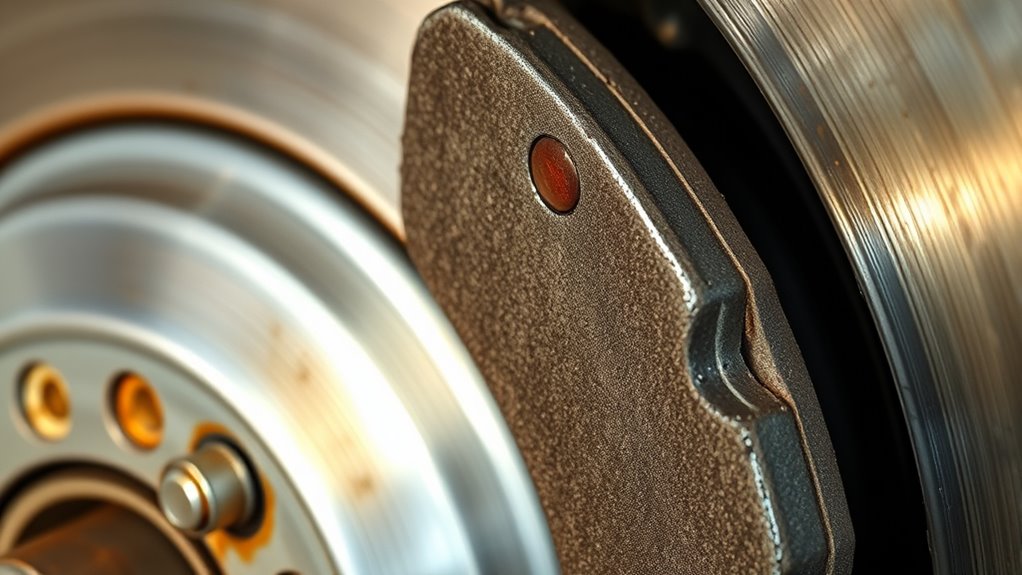
Many drivers postpone professional brake inspections because they’re worried about the cost. While saving money is understandable, delaying a proper inspection can lead to more expensive repairs later. Instead, look for cost-saving tips that balance affordability with safety. Regularly checking your brake fluid and listening for unusual noises can help spot issues early. Remember, DIY safety is vital—avoid attempting repairs beyond your skill level to prevent accidents or further damage. Investing in a professional inspection now can prevent costly repairs down the road. Some shops offer free or discounted brake checks, so don’t hesitate to ask. Prioritizing timely inspections not only keeps you safe but also saves money in the long run. Don’t let cost concerns keep you from maintaining your brakes properly. Additionally, understanding brake pad wear signs can help you determine when a professional inspection is truly necessary.
Using DIY Methods Without Proper Knowledge

Skipping professional brake inspections to save money might seem like a good idea, but attempting DIY repairs without proper knowledge can do more harm than good. DIY hazards include misdiagnosing issues, improper installation, and overlooking hidden problems. Many brake myths suggest you can fix worn pads easily, but shortcuts often lead to safety risks.
To avoid pitfalls:
- Never assume you know everything—consult reliable guides or experts.
- Use the right tools and replacement parts; cheap substitutes can compromise safety.
- Recognize your limits—complex brake issues require professional assessment.
Ignoring these precautions can worsen brake problems and jeopardize your safety. Remember, tackling brake repairs without expertise can turn minor issues into costly repairs, so always prioritize professional help over DIY shortcuts.
Neglecting Regular Brake Maintenance and Check-Ups
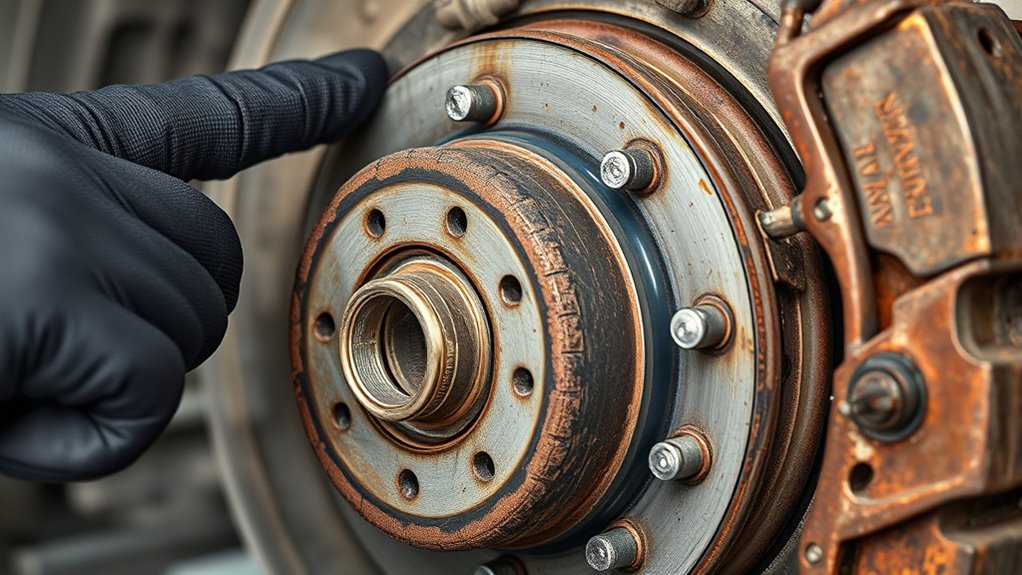
Neglecting regular brake maintenance and check-ups can lead to unnoticed wear and potential safety hazards. Without routine inspections, issues like low brake fluid levels or contaminated brake fluid may go unnoticed, reducing braking efficiency. Proper brake fluid maintenance ensures your braking system functions smoothly and prevents corrosion. Additionally, neglecting tire pressure checks affects overall vehicle safety and can cause uneven brake wear. Underinflated or overinflated tires put extra strain on your braking system, increasing the risk of premature pad wear. Regular check-ups allow you to catch these problems early, saving you money and enhancing safety. Vehicle maintenance is essential for ensuring all components work harmoniously. Don’t wait for warning signs—schedule routine brake inspections, monitor brake fluid levels, and keep tire pressure in check to maintain ideal brake performance.
Frequently Asked Questions
How Often Should Brake Pads Be Inspected Regardless of Symptoms?
You should inspect your brake pads at least every 10,000 to 15,000 miles, even if you notice no symptoms. Regular inspections help catch issues like brake squeal or brake vibration early. If you experience these signs, it’s especially important to check your pads, but routine checks prevent unexpected problems and maintain safe braking performance. Don’t wait for symptoms—stay proactive with your brake system maintenance.
Can Brake Pad Wear Be Detected Through Vehicle Handling Changes?
You might notice handling changes like pulling or vibrations, but brake pad wear isn’t always obvious from vehicle handling alone. Changes can stem from rotor condition or brake fluid issues too. Regular inspections reveal subtle signs before handling feels affected, helping you catch wear early. Relying solely on handling changes risks missing uneven wear or thinning pads, so routine checks are essential for maintaining safe braking performance.
What Are the Risks of Ignoring Minor Brake Issues Long-Term?
Ignoring minor brake issues can lead to serious risks over time. You might experience brake fluid leaks or reduced stopping power, increasing your chances of an accident. Plus, if you neglect these signs, rotor damage can occur, making repairs more costly. Address issues early to prevent damage, maintain safe braking performance, and avoid expensive repairs down the line. Regular inspections help catch problems before they escalate.
Are There Specific Signs of Brake Pad Wear in Different Vehicle Types?
Think of brake pad wear signs as whispers from your car’s health. Depending on your vehicle type, you’ll notice different signs: disc brake pads may squeal or feel less responsive, while drum brakes might cause pedal pulsation. Brake pad materials like ceramic or semi-metallic influence wear patterns, and uneven vehicle weight distribution can accelerate deterioration. Stay alert for these signs to keep your brakes reliable and your journey safe.
How Does Climate Affect Brake Pad Wear and Detection?
Climate impact greatly influences brake pad wear and detection. In hot, humid environments, brake pads wear faster due to increased moisture and heat, which can also make wear signs harder to spot. Conversely, cold climates may slow wear but cause uneven wear patterns. You should regularly inspect your brake pads and consider climate-specific wear detection methods, like checking for glazing or uneven pads, to guarantee safe braking performance year-round.
Conclusion
Don’t ignore warning signs like squealing or vibrations—these are your car’s way of telling you something’s wrong. Waiting too long can lead to costly repairs or unsafe driving conditions. Did you know that neglecting brake issues can increase stopping distance by up to 50%? Stay proactive with regular inspections and trust professionals. Address brake wear signs promptly, and you’ll keep yourself safe while saving money in the long run.

